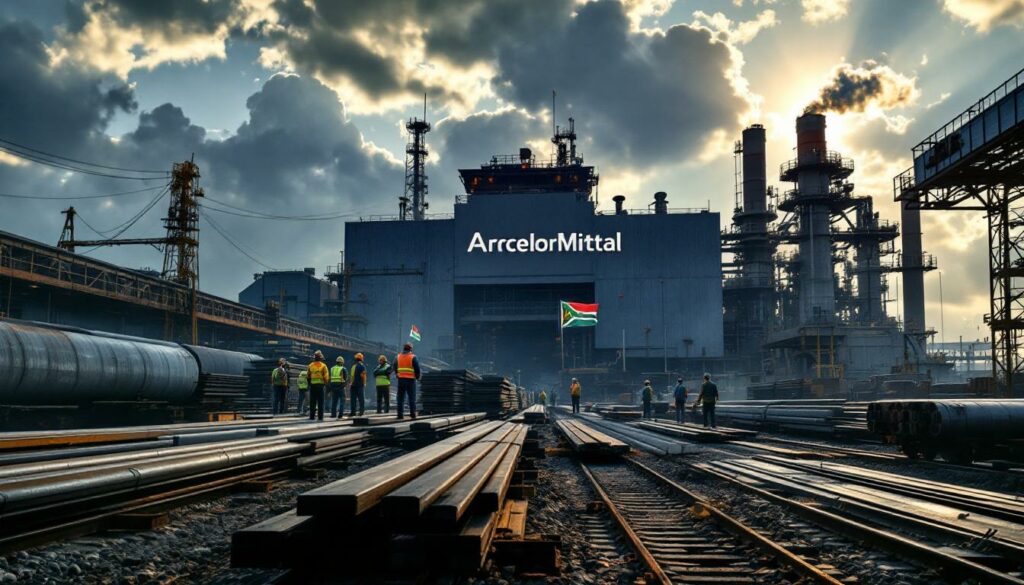The Uncertain Future of ArcelorMittal's Long Steel Business
ArcelorMittal South Africa has issued a stark update regarding its Long Steel division, warning that the business faces an uncertain future as its financial lifeline nears exhaustion. The R1.683 billion facility provided by the Industrial Development Corporation (IDC) has now been fully utilized, leaving the company at a critical juncture.
Unless significant structural and financial interventions are implemented by September 30, 2025, ArcelorMittal may proceed with an orderly wind-down of its Long Steel operations. Despite these challenges, the company has committed to continuing operations through the third quarter of 2025 to honor existing customer commitments.
The potential closure represents a significant shift in South Africa's steel industry landscape, with downstream implications for construction, infrastructure development, and manufacturing sectors that rely on domestically produced long steel products.
"The Long Steel division's continued viability hinges on addressing fundamental market and operational challenges that have persistently undermined its competitiveness," notes the company in its latest trading update.
Structural Market Constraints Plaguing the Long Steel Division
Several entrenched market dynamics have contributed to the division's precarious position. Chief among these is the difficulty in securing competitively priced scrap metal, a critical raw material for long steel production. The pricing structure for scrap metal in South Africa has disadvantaged domestic steel producers compared to international competitors.
This challenge is compounded by persistently weak demand for long steel products in the South African market. Construction activity, a primary consumer of long steel products such as rebar and structural sections, has remained subdued due to broader economic conditions and delays in infrastructure projects.
The division also continues to face intense competition from imported steel products flooding the local market. Despite various steel tariff exemptions for some countries, the tariff protection framework has proven insufficient to create a level playing field for domestic producers. These imports often arrive at prices that domestic manufacturers struggle to match due to their higher operational costs.
Operational Obstacles Creating Unsustainable Cost Pressures
Beyond market constraints, ArcelorMittal's Long Steel division grapples with severe operational challenges that have significantly increased its cost base:
- Rail service deterioration: Transnet's rail service has reached unprecedented poor levels, severely affecting the company's logistics capabilities
- Infrastructure failures: Persistent cable theft and locomotive breakdowns have disrupted supply chains
- Logistics cost burden: Additional logistics expenses amounting to R317 million have been incurred due to transportation challenges
- Energy cost disadvantage: Electricity expenses significantly higher than international competitors, undermining global competitiveness
The rail service challenges are particularly damaging, as they affect both incoming raw materials and outgoing finished products. Despite some rail service improvements in other regions, the company has been forced to utilize more expensive road transportation alternatives, resulting in the R317 million in additional logistics costs that have directly impacted the division's bottom line.
How Has the Six-Month Deferral Period Performed?
In March 2025, ArcelorMittal South Africa announced a six-month extension for its Long Steel division, aimed at exploring sustainable solutions while maintaining operations. This period was supported by the R1.683 billion facility from the IDC, providing a temporary financial cushion.
However, the company has now reported that minimal progress has been achieved in addressing the core challenges facing the division. The fundamental market constraints and operational obstacles remain largely unchanged, calling into question the division's long-term viability.
"Despite concerted efforts to identify sustainable solutions, the structural challenges facing the Long Steel division have proven resistant to short-term interventions," states the company's latest update.
Given the limited progress, ArcelorMittal has indicated that it might initiate wind-down preparations before the September 30 deadline if the outlook doesn't improve. This proactive approach aims to ensure an orderly transition that minimizes disruption to customers and stakeholders.
Business Continuity Through the Transition Period
Despite the uncertain future, ArcelorMittal has emphasized its commitment to honoring existing customer orders through the third quarter of 2025. This approach aims to provide customers with adequate time to secure alternative supply arrangements and minimize disruption to their operations.
The company plans to release its full interim financial results on July 31, 2025, which will provide more comprehensive details about the division's performance and future prospects. According to recent warnings from AMSA, approximately 3,500 jobs could be at risk if the Long Steel division were to close, highlighting the significant social impact of such a decision.
What is ArcelorMittal South Africa's Current Financial Position?
While the Long Steel division faces an uncertain future, ArcelorMittal South Africa's overall financial performance shows some signs of improvement, albeit while remaining in loss-making territory.
Trading Statement Highlights
According to the company's trading statement, interim loss per share is expected to improve by 15-25% year-on-year. Current projections indicate a loss of between R0.82 and R0.93 per share, compared to the R1.09 per share loss reported in the corresponding period of 2024.
Similarly, headline loss per share is forecast to be between R0.89 and R0.99, an improvement from the R1.00 per share headline loss recorded in the first half of 2024. These figures suggest that while the company continues to face challenges, there has been some moderation in its financial difficulties.
The company will release its unaudited results on the JSE's Stock Exchange News Service (SENS) by the end of July, providing investors and stakeholders with a more comprehensive picture of its financial health.
Operational Performance Metrics
On the operational front, ArcelorMittal South Africa has reported several notable developments:
- Safety improvements: The lost-time injury frequency rate has been reduced significantly to 0.44, down from 1.13 in the first half of 2024, reflecting enhanced workplace safety protocols
- Flat Steel production gains: Double-digit increases in production volumes following the restoration of Blast Furnace C, demonstrating operational improvements in this segment
- Sales volume challenges: Approximately 10% year-on-year reduction in overall sales volumes, primarily attributed to weaker market demand
- Price pressure persistence: Realized prices in rand terms more than 5% lower than in 2024, reflecting continued competitive pressures in the market
The improved safety performance stands out as a positive achievement amid the company's broader challenges, highlighting effective implementation of safety protocols and procedures.
How Does This Situation Compare to Previous Steel Industry Challenges?
The current challenges facing ArcelorMittal's Long Steel division reflect broader historical patterns in the global steel industry, which has long been characterized by cyclical boom and bust periods. However, several factors make the present situation particularly challenging.
Historical Context of Steel Industry Restructuring
The global steel industry has undergone significant restructuring over the past several decades, with consolidation and capacity rationalization becoming common responses to market overcapacity and pricing pressures. Many mature steel markets, including those in Europe and North America, have previously faced similar decisions regarding legacy steel assets.
South Africa's manufacturing sector has faced persistent pressures from infrastructure challenges, energy constraints, and global competition. The Trump tariffs impact on the global steel industry has further complicated the situation, creating additional market distortions. The country's steel industry has attempted various restructuring efforts in the past, but the current combination of challenges appears particularly severe.
Comparative Analysis with Other Steel Producers
Regional competitiveness factors significantly influence steel producers' viability. South African operations face unique challenges compared to their regional and global peers, including higher energy costs, logistics constraints, and limited domestic market size.
Global steel market dynamics continue to be shaped by significant capacity additions in countries like China, creating persistent pricing pressures across international markets. Ongoing US–China trade tensions have further disrupted global trade flows, affecting markets worldwide. This global context makes it increasingly difficult for higher-cost producers to remain competitive without specialized product offerings or protected markets.
What Are the Potential Outcomes for the Long Steel Division?
As the September 30, 2025 deadline approaches, several potential scenarios could unfold for ArcelorMittal's Long Steel division.
Scenario Analysis
A complete wind-down remains the most likely outcome if significant interventions are not implemented by the deadline. This would involve the systematic closure of facilities and cessation of operations in an orderly manner.
Partial restructuring options might also be considered, potentially maintaining operations at the most efficient facilities while closing others. This approach could preserve some capacity and jobs while reducing the overall cost base.
The possibility of a strategic buyer emerging remains, though industry conditions make this challenging. A buyer with complementary operations or specialized market focus might see value in specific assets.
Government intervention could also play a role, given the strategic importance of steel production to South Africa's industrial base and the significant employment implications. Australia's tariff counterplan for similar situations may provide instructive lessons, though fiscal constraints may limit the scope of potential support measures.
Impact Assessment
The closure of ArcelorMittal's Long Steel division would have significant implications for South Africa's steel supply chain. Downstream industries and customers would need to secure alternative supply sources, potentially leading to increased reliance on imports.
The employment consequences would be substantial, with approximately 3,500 direct jobs at risk, not counting the indirect employment effects on suppliers and service providers.
The resulting market gap would likely be filled by imports and potentially by other domestic producers if they can expand capacity. However, this transition could lead to short-term supply disruptions and price volatility.
The broader economic ripple effects would extend beyond the steel industry, affecting communities where ArcelorMittal's facilities are located and potentially further weakening South Africa's manufacturing base.
FAQ: ArcelorMittal's Long Steel Division Situation
What is the difference between ArcelorMittal's Flat Steel and Long Steel businesses?
Flat steel products include sheets and plates used in automotive manufacturing, appliances, and construction, while long steel products encompass bars, rods, rails, and structural sections primarily used in construction and infrastructure projects. The Flat Steel division has shown better performance, with production increases following the restoration of Blast Furnace C, while the Long Steel division faces more severe challenges.
How significant is the Long Steel Division to ArcelorMittal South Africa's overall operations?
The Long Steel Division represents a substantial portion of ArcelorMittal South Africa's business, with significant production capacity and workforce. Its potential closure would mark a major restructuring of the company's operations in South Africa, affecting approximately 3,500 jobs and reshaping the domestic steel market landscape.
What external factors are contributing to the division's challenges?
External factors include global steel overcapacity creating pricing pressures, economic slowdown affecting construction activity and steel demand, infrastructure challenges in South Africa (particularly rail transportation), electricity supply issues and cost, and logistical constraints. Transnet's deteriorating rail service has directly resulted in R317 million in additional logistics costs for the company.
What alternatives might exist to complete closure?
Alternatives could include partial operation of more efficient facilities, strategic partnerships with other industry players, government support programs, or restructuring to focus on higher-margin specialty products. However, the company has indicated that minimal progress has been made in identifying sustainable alternatives during the six-month deferral period, suggesting limited viable options remain.
"The structural challenges facing South Africa's steel industry require coordinated action from multiple stakeholders, including government, infrastructure providers, and the private sector," industry analysts note.
Readers interested in learning more about the steel industry in South Africa can also explore related educational content from Mining Review Africa at miningreview.com, which offers additional perspectives on developments in the mining and metals sectors across the African continent.
Ready to Spot the Next Major Mining Opportunity?
Discovery Alert's proprietary Discovery IQ model instantly notifies investors of significant ASX mineral discoveries, translating complex data into actionable insights that give you a market-leading advantage. Explore why historic discoveries generate substantial returns by visiting the Discovery Alert discoveries page and begin your 30-day free trial today.




